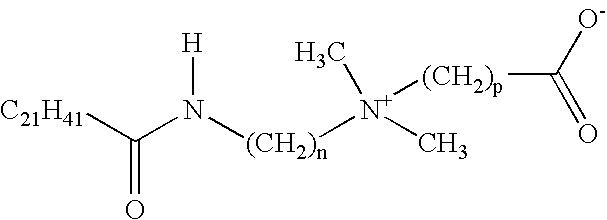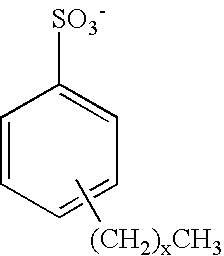Viscoelastic Surfactant Fluids Stable at High Brine Concentration and Methods of Using Same
a viscoelastic surfactant and high brine concentration technology, applied in the direction of sealing/packing, chemistry apparatus and processes, and well accessories, can solve the problems of high brine concentration and limited application range of heavy fluids to balance the well pressure, and achieves easy creation of turbulence, regained viscosity, and efficient jet
- Summary
- Abstract
- Description
- Claims
- Application Information
AI Technical Summary
Benefits of technology
Problems solved by technology
Method used
Image
Examples
example 2
[0060] Data from Fann 50 experiments showed that formulations of 7.5% and 10% BET-E-40 in 1.44 to 2.16 kg / L (12 to 18 ppg) CaCl.sub.2 and CaCl.sub.2 / CaBr.sub.2 mixtures had rheological stability beyond 149 .degree. C. (300 .degree. F.). FIG. 3 shows the rheology of 7.5% BET-E-40 in CaCl.sub.2 with densities ranging from (1.09 to 1.31 kg / L (9.1 to 10.9 ppg). The fluids shown in FIG. 3 also contained 1% methanol.
[0061] FIG. 4 shows the rheology of 10% BET-E-40 fluids in mixed CaCl.sub.2 and CaBr.sub.2 brines with fluid densities up to 1.81 kg / L (15.1 ppg). The CaBr.sub.2 / CaCl.sub.2 weight ratio in the 1.56 kg / L (13 ppg) fluid was about 2.0; the ratio in the other two fluids was about 2.8. The three fluids were shear thinning (in the conventional sense) over the entire temperature range shown. 1.81 kg / L (15.1 ppg) is the highest density available for this brine.
[0062] Table 3 shows rheological data from Fann 50 experiments for a fluid made with 10% as-received BET-E-40 in a 1.56 kg / L ...
PUM
| Property | Measurement | Unit |
|---|---|---|
| Concentration | aaaaa | aaaaa |
| Density | aaaaa | aaaaa |
| Density | aaaaa | aaaaa |
Abstract
Description
Claims
Application Information
 Login to View More
Login to View More - R&D
- Intellectual Property
- Life Sciences
- Materials
- Tech Scout
- Unparalleled Data Quality
- Higher Quality Content
- 60% Fewer Hallucinations
Browse by: Latest US Patents, China's latest patents, Technical Efficacy Thesaurus, Application Domain, Technology Topic, Popular Technical Reports.
© 2025 PatSnap. All rights reserved.Legal|Privacy policy|Modern Slavery Act Transparency Statement|Sitemap|About US| Contact US: help@patsnap.com



